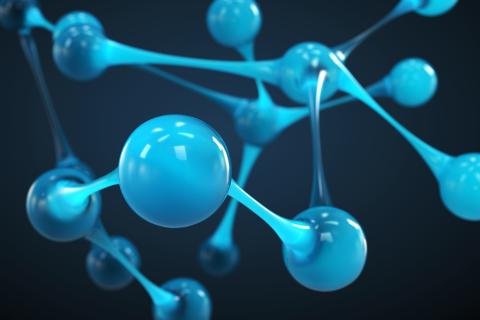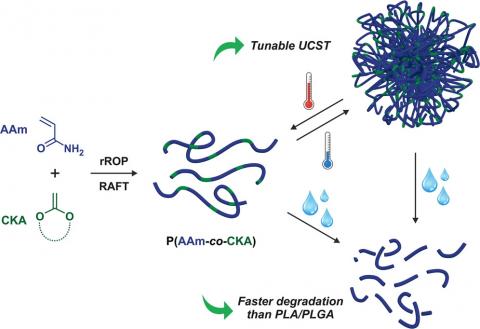
Weakening vinyl polymers for better degradation
Julien Nicolas’ team at the Institut Galien Paris Saclay (IGPS – Université Paris-Saclay, CNRS) has created vinyl polymers with novel degradation properties. These are made of polyacrylamide and other functional groups which create fragility. From nanomedicine to water treatment, the applications of such a material are numerous.
Vinyl polymers, which are members of the large family of plastics, are macromolecules obtained by polymerisation of monomers with a carbon-carbon double bond. The synthesis of this type of macromolecule is highly developed and they are produced in vast quantities for many fields of application. However, due to their high stability, vinyl polymers are not degradable. “The carbon-carbon bonds which are the backbone of vinyl polymers are very strong, which prevents these materials from degrading,” explains Julien Nicolas, who directs the Nanomedicines for the treatment of serious diseases team at IGPS. “To make them degradable, degradable monomers named cyclic ketene acetals (CKAs) are inserted during the synthesis as points of fragility distributed throughout the polymer chain. The CKA are added as a minority fraction (up to 23%). These points of fragility will then be cleaved, either hydrolytically (by water) or enzymatically (e.g. by esterases), to obtain the fragmentation of the polymer.”
A pre-existing copolymerisation strategy
The radical ring-opening copolymerisation (or cleavable monomer strategy) used by Julien Nicolas’ team is already widely cited in papers. “This, however, is the first time that a copolymerisation process between a vinyl monomer (in this case acrylamide) and a CKA results in a material which degrades very quickly in water (by about 70% in seven days)!” For comparison, well-known biodegradable polymers such as polylactic acid or polycaprolaptone require several months to several years to reach a similar stage of degradation under the same conditions.
In addition to the rapid degradation which these new polyacrylamide copolymers exhibit, they are also thermosensitive. This means that these copolymers will be insoluble below a certain temperature (the transition temperature), but soluble above it. This transition temperature can also be adjusted by changing the proportion of CKA incorporated in the polymer. Such thermosensitive vinyl polymers already exist. “However, they aren’t degradable. Our new polymers combine both these aspects,” explains Julien Nicolas.
This study took place as part of the THERMONANO project, which is led by Julien Nicolas and which won the Consolidator Grant from the European Research Council (ERC) in 2017. The project focused on nanoassemblies for the subcutaneous delivery of active anticancer ingredients. “The idea was to switch from intravenous chemotherapy, which is complex, cumbersome and costly for patients, to subcutaneous chemotherapy. This is much easier to implement, much less invasive (and therefore more comfortable for patients) and less expensive. We initially wanted to develop thermosensitive and degradable polymers based on synthetic polypeptides, but unfortunately this didn’t work out,” remembers Julien Nicolas. “So, we turned to this alternative route involving vinyl polymers. This very rapid degradation was a chance discovery in the end. We weren’t expecting it! ”
A variety of potential applications in the biomedical field and beyond
The rapid degradability and thermosensitivity of these new polymers developed in the laboratories at IGPS have properties which would make them the ideal nanovectors for drug delivery, according to Julien Nicolas. “It's interesting because we could formulate this polymer into nanoparticles loaded with active ingredients. By setting the transition temperature of the polymer slightly above 37°C, this would allow a rapid release of the entire active ingredient by simply raising the temperature locally. In addition, the polymer would be subsequently degraded and therefore more easily eliminated from the human body,” explains the researcher. Polyacrylamide has properties similar to those of polyethylene glycol (PEG), a polymer which is well known in nanomedicine and is notably used to protect and stabilise the nanoparticles encapsulating the messenger RNA (mRNA) used against Covid-19. “Polyacrylamide, like PEG, is biocompatible and gives the nanoparticles stealth properties, i.e. they are not immediately recognised by the immune system, giving them a longer circulation time in the body. However, the advantage of polyacrylamide is that it’s even more hydrophilic than PEG. ”
In addition to biomedical applications, polyacrylamide polymers are commonly used in several other industrial sectors (wastewater treatment, paper industry, textile industry, oil exploration, etc.). The chemistry developed by Julien Nicolas’ team could lead to the development of new degradable materials for these applications.
The team is also continuing to study this polymer in order to influence its degradation rate in particular. “The degradation observed is very fast, and it would be interesting to succeed in modulating it by modifying the structure of the monomers involved in order to best serve the targeted application. For example, regarding stealth nanoparticles introduced into the human body, degradation in a few days or weeks is rather important. If, instead, it's of the order of several months or even years, it could become too long because it would lead to an accumulation of polymers in the body,” points out Julien Nicolas. This is a challenge which researchers in this team will try to meet in the coming years.
References:
Bossion A. et al., Vinyl Copolymers with Faster Hydrolytic Degradation than Aliphatic Polyesters and Tunable Upper Critical Solution Temperatures. Nature Communications 2022, DOI: 10.1038/s41467-022-30220-y

